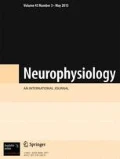Abstract
Electroencephalographic examination of 7-to 9-year-old children with sensorineural deafness of degrees II and III included EEG recording in the resting state, in the course of reaction of activation (at opening of the eyes), under conditions of rhythmic photostimulation with frequencies of 4, 6, 9, and 12 sec−1 and under those of the hyperventilation test. The results allow us to conclude that systems responsible for generation of EEG in hard-of-hearing children demonstrate some functionally immaturity. The following facts confirm the above conclusion. As compared with the norm, greater normalized spectral powers (SPs) of the delta and theta rhythms, a higher intensity of electrogenesis (integral power of oscillations) within all frequency ranges, and a smaller mean frequency of the dominant rhythm were typical of hard-of-hearing children. In these children, the reaction of activation in the majority of cases looked like incomplete suppression of the alpha rhythm. Upon rhythmic photostimulation, hard-of-hearing boys and girls demonstrated following of the rhythm at frequencies of 4 and 6 sec−1 while children with normal hearing demonstrated that at 9 and 12 sec−1 frequencies. The characteristics of EEG reactions under the conditions of the hyperventilation test reflected the immaturity of the fronto-thalamic controlling system, as well as certain dysfunction of lower brainstem regions in children with disorders of hearing.
Similar content being viewed by others
References
Detection of Disorders of Hearing among Newborn Children and Infants (Methodical Recommendations) [in Ukrainian], Ukrmedpatentinform, Kyiv (2005).
Examination of Somato-Neurologic Peculiarities in Schoolchildren with Hearing Disorder. Methodical Recommendations [in Russian], RUMK of Special Schools, Kyiv (1980).
L. A. Novikova, Electrical Activity of the Brain Modified by Disorders of Distant Receptors [in Russian], Abstr. of Doctoral Thesis, Med. Sci., Moscow (1965).
R. I. Roman and N. O. Machinskii, “Analysis of EEG rhythmic oscillations of alpha-range in the norm and deep hearing disorder,” Fiziol. Cheloveka, 9, No. 1, 66–72 (1983).
L. P. Grigor’eva, N. N. Zislina, and V. A. Tolstova, “On theoretical and practical importance of neuropsychophysiological studies in speech pathology,” Defektologiya, No. 5, 15–26 (1997).
N. K. Blagosklonova and L. A. Novikova, Child Clinical Electroencephalography [in Russian], Meditsina, Moscow (1994).
L. R. Zenkov, Clinical Electroencephalography (with elements of epileptology). Manual for Physicians [in Russian], MEDpressinform, Moscow (2004).
V. T. Pal’chun, Neurological Aftereffects of Illness in otorhinolaryngology [in Russian], Meditsina, Moscow (1977).
D. A. Farber and N. V. Dubrovinskaya, “Formation of neurophysiological functions in ontogenesis,” in: Mechanisms Underlying the Functioning of the Human Brain [in Russian], Nauka, Leningrad (1986), pp. 426–451.
R. I. Machinskaya, “Functional maturation of the brain and formation of neurophysiological mechanisms of selective unconditioned voluntary attention in children of primary school age,” Fiziol. Cheloveka, 32, No. 1, 26–36 (2006).
M. N. Livanov, Spatial-Temporal Organization of Potentials and Systemic Functioning of the Brain [in Russian], Nauka, Moscow (1989).
S. S. Bekshaev, S. I. Soroko, and N. N. Vasilevskii, “Regularities underlying the maintenance of dynamic stability of EEG ranges in human,” Fiziol. Cheloveka, 14, No. 4, 545–561 (1988).
D. A. Farber and N. V. Dubrovinskaya, “Ontogenetic analysis of EEG reactions of activation in children,” Zh. Vyssh. Nerv. Deyat., 33, No. 3, 442–448 (1983).
N. V. Koroleva, S. A. Nebera, and I. N. Gutnik, “Leading indices of maturation of bioelectrical activity of the brain in 1-to 7-year-old children,” Fiziol. Cheloveka, 28, No. 6, 57–63 (2002).
L. V. Sokolova and D. A. Malyshev, “Electroencephalographic and neuropsychological studies of functional maturation of the cerebral cortex in first graders with different levels of the development of memory,” Fiziol. Cheloveka, 32, No. 1, 75–79 (2006).
P. Ucles, S. Lorente, and F. Rosa, “Neurophysiological methods testing the psychoneural basis of attention deficit hyperactivity disorder,” Child’s Nerv. Syst., 12, 215–217 (1996).
G. Dehaene-Lambertz, “Cerebral specialization for speech and non-speech stimuli in infants,” J. Cogn. Neurosci., 12, No. 3, 449 (2000).
Author information
Authors and Affiliations
Corresponding author
Additional information
Neirofiziologiya/Neurophysiology, Vol. 40, No. 2, pp. 137–146, March–April, 2008.
Rights and permissions
About this article
Cite this article
Tarasova, O.A. Peculiarities of EEG in hard-of-hearing children of primary school age. Neurophysiology 40, 121–129 (2008). https://doi.org/10.1007/s11062-008-9022-7
Received:
Published:
Issue Date:
DOI: https://doi.org/10.1007/s11062-008-9022-7


